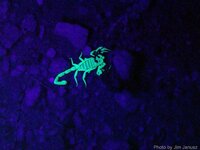Bejay
Bronze Member
- Mar 10, 2014
- 1,026
- 2,530
- Detector(s) used
-
Whites GMT
Garret fully underwater
- Primary Interest:
- Prospecting
My grandfather was a desert prospector and he spent a lot of time out in the desert looking for highly mineralized zones.
During the day it is easy to walk past areas that have extreme mineralization. He knew that high mineralized fluorescent zones were associated with other minerals of value.
So in 1950 he invested in a prospectors black light. It had a battery pack that fastened to his belt and it powered a hand held "wand" powerful black light. I own the unit to this day...unfortunately I broke the lens and have to have one custom made....but the Southern Calif company who made it in 1950 is now in Seattle Wash.
My grandfather would venture out into the desert at night seeking to find fluorescent minerals. He would carry marker sticks and labeled bags in which he could place samples. When he found a fluorescent area he would post it with a stake/flag pole and place samples in his bag. He could visit the area again during the day.
Such fluorescent areas are NOT noticed during the daytime. The samples always varied and I'll post a link to help visualize what one can see at night prospecting with the right black light.
Fluorescent Minerals and Rocks: They Glow under UV Light!
Additionally along the Columbia river in Oregon one could go out at night and use the black light on the dredge spoils and find valuable gems. It was thought that pirate ships trying to escape the law would toss trunks of heavies into the river to relieve ballast and outrun the law (ships). Not sure on the validity of the speculation but I did see highly prized gems that were found by a neighbor man...as I was just a youngin at the time.
Bejay
During the day it is easy to walk past areas that have extreme mineralization. He knew that high mineralized fluorescent zones were associated with other minerals of value.
So in 1950 he invested in a prospectors black light. It had a battery pack that fastened to his belt and it powered a hand held "wand" powerful black light. I own the unit to this day...unfortunately I broke the lens and have to have one custom made....but the Southern Calif company who made it in 1950 is now in Seattle Wash.
My grandfather would venture out into the desert at night seeking to find fluorescent minerals. He would carry marker sticks and labeled bags in which he could place samples. When he found a fluorescent area he would post it with a stake/flag pole and place samples in his bag. He could visit the area again during the day.
Such fluorescent areas are NOT noticed during the daytime. The samples always varied and I'll post a link to help visualize what one can see at night prospecting with the right black light.
Fluorescent Minerals and Rocks: They Glow under UV Light!
Additionally along the Columbia river in Oregon one could go out at night and use the black light on the dredge spoils and find valuable gems. It was thought that pirate ships trying to escape the law would toss trunks of heavies into the river to relieve ballast and outrun the law (ships). Not sure on the validity of the speculation but I did see highly prized gems that were found by a neighbor man...as I was just a youngin at the time.
Bejay
Amazon Forum Fav 👍
Upvote
0



 ) So to get the most samples you'll need a short wave unit. Once you have both types, you can even find samples that will glow different colors under different wavelengths of U.V.
) So to get the most samples you'll need a short wave unit. Once you have both types, you can even find samples that will glow different colors under different wavelengths of U.V.
